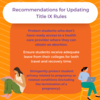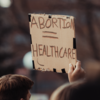In June 2022, the Supreme Court of the United States made the inhumane decision to strip away the constitutional right to abortion. Its dire consequences are already reverberating across U.S. college campuses, curtailing the freedom of students and threatening their potential.
The stakes are high. Students pursuing higher education are increasingly reconsidering where they want to go to college as new state laws severely restricting or banning abortion spread throughout the country. Now, it’s not just the oft-inaccessible tuition cost that looms large in choosing a college—but also the question of what one’s right to privacy and basic health care services will be where they attend.
In Texas alone, more than 50,000 abortions were performed every year prior to the state banning abortion, and more than half of those abortions were for patients between the ages of 20-29 years old. Students attending college in states with abortion bans must now contend with devastating disruptions to their dreams if they’re faced with an unwanted pregnancy.
The Dobbs decision stripped the rights of women and other people who can become pregnant to make decisions about their own health care. But the decision also exacerbates another crisis in higher education: student basic needs insecurity.
College students are already balancing the extreme costs of higher education and often end up in significant debt to pay for it. Few students have the financial resources, time, and family support they need to navigate an unexpected pregnancy and raise a child while going to college. The increased costs, health risks, and time burdens that ensue from Dobbs will further deter the dreams of countless students.

Source: The Hope Center Student Basic Needs Survey 2021
Exacerbating inequities
The exacerbation of already woeful inequities is likely. Black, Latina, and Brown women, students with low incomes, and those who have been continuously and systemically marginalized will be most affected by the Court’s decision.
Unfortunately, Latina, Black and Brown women already face a disproportionate level of financial stress and burden from college. The Hope Center’s data reveal that three in five college students experience food or housing insecurity, and Black, Brown, Indigenous, and parenting students experience basic needs insecurity at even higher rates.
What’s more, more than half (65 percent) of LGBTQ+ students were also most likely to experience some form of basic needs insecurity. The LGBTQ+ community is often left out of conversations concerning abortion, yet is most likely to experience barriers to reproductive health care.

Undocumented students living in states that ban abortion will be forced to navigate the threat of deportation just for trying to obtain health care. For instance, college students in south Texas seeking travel for abortions will often need to pass through Border Patrol checkpoints, heightening risks as they interact with law enforcement. Most students work while in school and can’t afford to take time off work. Traveling across states—sometimes multiple states—for abortion care won’t always be feasible and will rarely be affordable. While wealthier students seeking abortions will have access to better resources, students with the fewest financial resources will be left to juggle multiple competing college expenses on their own, including essential costs of living that go far beyond tuition and fees.
One study on the impact of abortion bans found that one of the main reasons for students stopping out of college was due to unexpected pregnancies, especially among community college students. Another study found that states with abortion restrictions for women under 18 experienced reduced rates of college enrollment and attainment, with a particularly pronounced impact on Black women.

Source: Institute for Women's Policy Research
Abortion bans will also increase the number of parenting students on college campuses. Higher education is already failing to support parenting students. Currently, one in five undergraduates in college are parenting students, and roughly 1.7 million students are single mothers—yet only 8 percent of single moms complete their degree within six years

Source: The Hope Center Student Basic Needs Survey 2021
This is partly due to greater basic needs insecurity; 70 percent of parenting students experience basic needs insecurity, compared to 55 percent of non-parenting students. Subsidized child care only reaches 15 percent of all eligible families, and the number of on-campus child care centers has actually been declining in number despite new federal investments.
COVID-19 exacerbated this problem—many campus child care centers closed as a result of the pandemic and struggled to reopen as students returned to campus. Very few campuses provide family-friendly housing on campus. Public benefit programs meant to address families’ basic needs are often unavailable to students due to confusing and contradictory rules, like work requirements that force students to choose between full-time work and education. Even before Dobbs, parenting students were forced to navigate a higher education system not built to support them.
Recommendations
Fortunately, there are areas where the Biden-Harris Administration can take executive action—and bypass a divided Congress—to protect students and shield them from the worst consequences of the Dobbs ruling.
The Administration deserves credit for already taking meaningful steps in the right direction, such as forming the President’s Task Force on Reproductive Healthcare Access which includes the U.S. Department of Education, and is taking executive actions to protect patient privacy and access to care. Vice President Harris has also amplified the voices of students, higher education leaders, and advocates working to protect abortion access.
In addition to these steps, it is critical that the Administration take a bold stand to safeguard abortion access for students in higher education. The Administration has reminded colleges that longstanding federal laws like Title IX protect pregnant and parenting students from discrimination and require leaves of absence in certain cases, but the underlying regulations need a major overhaul.

The Title IX rules should be updated to protect students who don’t have ready access to a health care provider where they can obtain an abortion, ensure students receive adequate leave from their college for both travel and recovery time, and stringently protect student privacy related to pregnancy or related conditions (including the termination of a pregnancy).
Students attending college in states that ban abortion will also need adequate financial aid to travel to other states, and the Administration can encourage this by establishing “cost of attendance” rules that account for the full range of a student’s health care expenses (including reproductive health) and an accessible pathway for students to appeal their financial aid package for more funding if they have an unexpected expense.
Finally, the Administration can play a leadership role in encouraging college leaders to support abortion access. Secretary of Education Miguel Cardona should encourage college and state leaders to provide financial and legal assistance to students that need to travel out-of-state or want to purchase medication abortion, and to create or expand affordable on-campus health services that include reproductive care.
States have a responsibility to step up as well. Legislatures and governors should look for all avenues to reduce barriers for students who need access to abortion or contraception by adopting policies and establishing grants that address the high cost of medication abortion and traveling out-of-state. States should follow California’s lead and Massachusetts' pending bill requiring public universities to provide students access to medication abortion and avoid excluding community college students whose needs remain high. Emergency aid grants are another proven strategy to help students manage unexpected expenses that can otherwise hinder their ability to stay enrolled in college, and state-based emergency aid programs should continue to grow as federal funds have dried up.

Some institutions of higher education have also led by example by providing free emergency contraceptives, free transportation to local health services, and on-campus medication abortion.
Colleges should go further and provide emergency funds for students to travel out-of-state, particularly if they are in a state that restricts or bans abortion. Finally, students need transparent information about their rights (i.e. FERPA), including to whom it's safe to talk on campus among health centers, counselors, and faculty or staff. Colleges should tell students where they can access resources like local health providers, hotlines, and contraceptives. At the bare minimum, institutions of higher education must provide flexible attendance and leaves of absence on demand for students for both travel and recovery time – no questions asked.
At a time when students and families are grappling with the future of reproductive health care and a radical curtailment of their rights, federal, state, and college leaders must step in with decisive action to guarantee students’ access to abortion and reproductive care. Students deserve nothing less.


